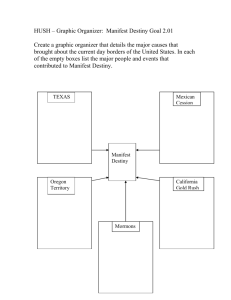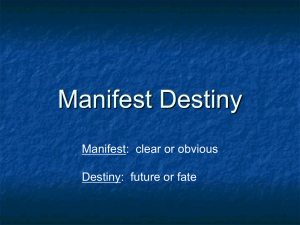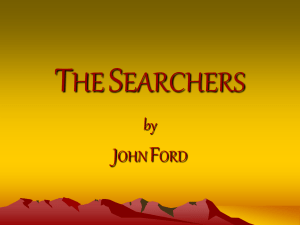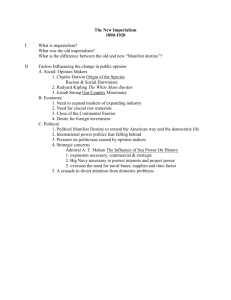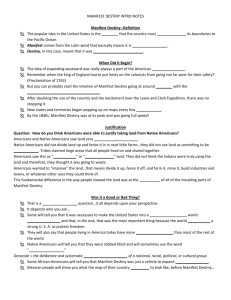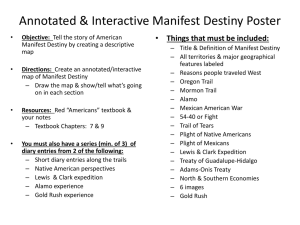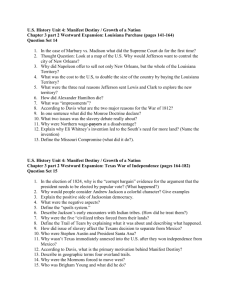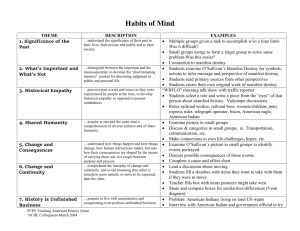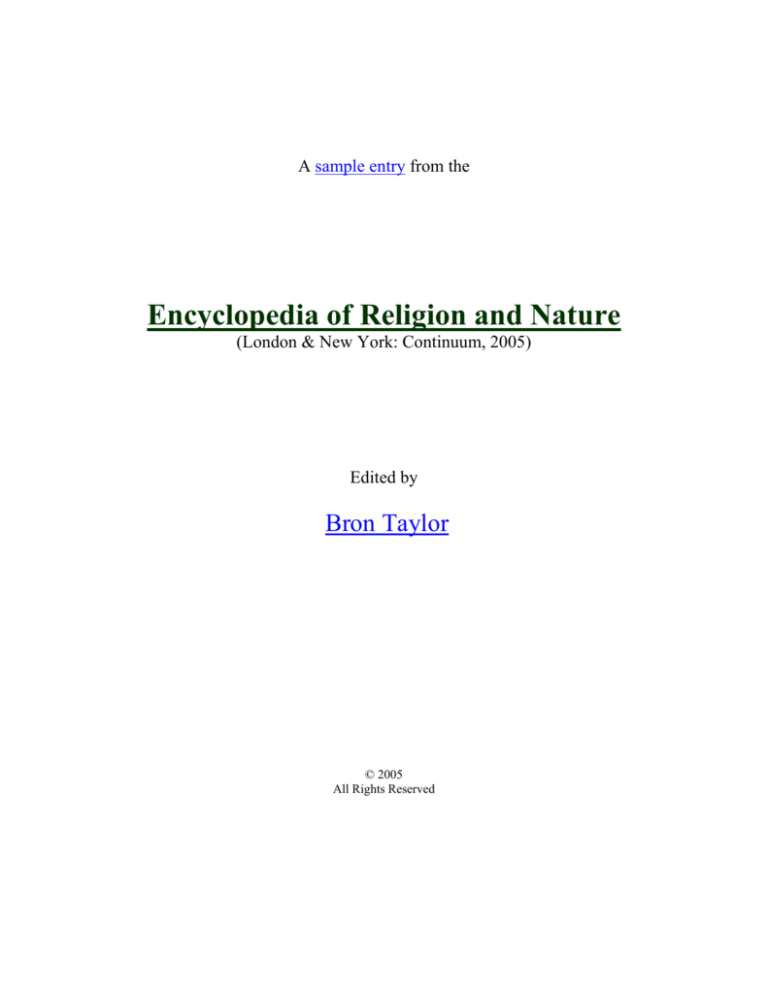
A sample entry from the
Encyclopedia of Religion and Nature
(London & New York: Continuum, 2005)
Edited by
Bron Taylor
© 2005
All Rights Reserved
1038
Manifest Destiny
death of the nobleman. The death of a tiger, described as
the king of the forest, is similarly commemorated.
In Mandailing society, the management of the
environment is tied to the origin of clans and settlement,
social structure, system of land tenure, governance and
sense of territory. Mandailing society in the past and up to
this day is a rural, agrarian and pastoral society. The main
agricultural activity is paddy planting. Ownership of a plot
of paddy land is critical to Mandailing social life as it
defines one’s standing and status in society.
In the Mandailing perspective, a territorial unit is only
complete when it constitutes land and water. The land and
water in a settlement is communally owned and its usage
has to conform to the customs as well as the sanction of
the council of nobles and elders.
The water systems in Upper Mandailing are a feat of
traditional water management and engineering. An
extensive irrigation system provides for religious,
domestic, agricultural and other uses. As such, settlements
are strung all along the streams and river banks, traversed
by path and canals leading to the paddy fields. One
can hear the water flowing twenty-four hours a day in a
typical Mandailing settlement.
Mandailing settlements are always located near a
spring, stream or a river, which is used for domestic, agriculture, fisheries and religious/ritualistic purposes. Each
territorial unit has its own protected forest area, where
agriculture, hunting and harvesting of forest products are
prohibited. These are usually watershed areas, believed to
be where the spirits lived.
Inspired by the traditional concept of protected areas,
local communities in the Mandailing homeland have been
overseeing the implementation of a river-protection program. The practice prohibits the harvesting of fisheries’
resources close to human settlements for a stipulated
period. Implemented in seventy settlements, Mandailing
has the largest river-protection scheme in the province of
North Sumatra.
The income derived from the harvesting of river
resources is used to pay for the development of social
facilities such as schools, roads and mosques, providing
educational scholarships and administrative salaries,
charity toward orphans, the poor and invalids, etc. The
income generated by this community-based ecological
resource-management program benefits the community
directly.
Both mother and child “village republics” are autonomous in implementing their system of governance. The
general rule is that the chief of the Nasution clan rules
settlements in Lower Mandailing while the nobleman of
the Lubis clan rules settlements in Upper Mandailing, but
there are exceptions.
The Mandailing nobleman governs in council, in that
he acts in concert with his counselors. The nobles and
elders jointly carry out their duties and obligations of
governance and customary laws, which cover not only
social and ceremonial matters such as marriage but also
matters of local governance such as division of new paddy
lands, rights of water and pastoral land, and so forth.
Although the territorial units were terminated by the
Japanese imperial army in the 1940s, which meant that
the nobles and elders lost their territoriality and powers
to function effectively in Mandailing society, it did not
wipe them out of existence, and to this day, the nobles
and elders still play a recognized role as arbiters of the
customs, although their authority is circumscribed.
Abdur-Razzaq Lubis
Further Reading
Harahap, Basyral Hamidy. “The Political Trends of South
Tapanuli and its Reflection in the General Elections
(1955, 1971 and 1977).” In Rainer Carle, ed. Cultures
and Societies of North Sumatra. Dietrich Reimer
Verlag, 1989.
Harahap, Basyral Hamidy. “Islam and Adat among South
Tapanuli Migrants in Three Indonesian Cities.” In
Rita Smith Kipp and Susan Rodgers, eds. Indonesian
Religions in Transition. Tucson, AZ: The University of
Arizona Press, 1987, 221–37.
Kartomi, Margaret. “Lovely When Heard From Afar”:
Mandailing Ideas of Musical Beauty in Five Essays
on the Indonesian Arts – Music, Theatre, Textiles,
Painting and Literature. Monash, Australia: Monash
University, 1981.
Lubis, Abdur-Razzaq. “Transformation of Mandailing
Cultural Identity and Leadership.” Journal of the
Malaysian Branch of the Royal Asiatic Society
(JMBRAS) 76 (2003), part 1.
Lubis, Abdur-Razzaq and Khoo Salma Nasution. Raja
Bilah and the Mandailings in Perak, 1875–1911,
(Monograph No. 35). Kuala Lumpur: MBRAS, 2003.
Lubis, Dr. Z. Pangaduan. “Ideas of Governance in the
Built Heritage of Mandailing, Sumatra.” Asia & West
Pacific Network for Urban Conservation (AWPNUC)
Newsletter 5:3 (1999), 7–9.
Traditional Buildings of Indonesia, Batak Simalungun and
Batak Mandailing, vol. 3. Bandung: United Nations,
Regional Housing Centre, ESCAFE, 1973.
Tugby, Donald. Cultural Change and Identity: Mandailing
Immigrants in West Malaysia. St. Lucia, Australia:
University of Queensland Press, 1977.
Tugby, Donald J. “The Social Function of Mahr in Upper
Mandailing, Sumatra.” American Anthropologist 61:4
(1959), 631–40.
Manifest Destiny
Coined by New York journalist John O’Sullivan in 1845,
the term “manifest destiny” played an important, conten-
Manifest Destiny
tious role in American territorial expansion during the
nineteenth century, and has had a lasting but equally
fractious impact on American self-understanding in years
since. Components of the idea of manifest destiny have a
long and influential history in the United States, appearing in the guises of religious and political discourse, as
well as in both elite and popular culture before and after
their constellation within O’Sullivan’s editorial work
supporting American annexation of Texas and Oregon. In
its various usages, the term encompasses nature, geography and race as key determiners of American values and
institutions. For its proponents, it has typically served to
attribute a sacred quality to American lands, one achieved
through the work of subduing both raw nature and
“inferior” peoples.
The oldest, and perhaps most crucial, component to the
idea of manifest destiny is millennial. Early European
colonists, most consistently the Puritans of New England,
drew frequently on the Bible’s millennial traditions in
order to frame both their own colonizing agendas, and
their view of the new world landscape to which they had
migrated. As a sacred enterprise, their establishment
of Massachusetts settlements was an analogue of the
Israelites’ exodus from Egypt to the land of milk and
honey. The New Canaan, to which God led English
Puritans as his newly chosen people, was an appropriation
of widely embraced English Protestant ideas correlating
the Israelite and English monarchies. Thus the Puritans did
not so much coin the analogy as they deprived England’s
establishment of the analogy’s “proper” use. But while
Church of England expositors had to make biblical
language of the wilderness and the heathen tribes metaphors for papal power, the New England Puritans were
able to carve out a Christian beachhead in real wilderness,
“full of wilde beasts and wilde men,” as the Plymouth colony’s first governor William Bradford put it. Just as the
establishment of Israel was necessary for the history of
redemption culminating in the life of Jesus of Nazareth,
New Englanders came to see their own wilderness enterprise as crucial to redemption’s second phase. In a kind of
divine balance of history, since – as theologian Jonathan
Edwards calculated – the “other continent hath slain
Christ, and has from age to age shed the blood of the saints
and martyrs of Jesus,” it was reasonable to conclude that
God would use the newly settled one to bring history to its
glorious end (in Cherry 1971: 56).
In the meantime, New Englanders transformed their
physical surroundings, guided by the biblical injunctions
of Genesis 1:26, and the Arcadian vision of a subdued and
bountiful nature subject to human enterprise. At times, as
in judge Samuel Sewall’s 1697 musings on New England’s
millennial role, this vision of New World abundance
stressed a notable harmony between humans, nature, and
divine intention: “as long as nature shall not grow old and
dote, but shall constantly remember to give the rows
1039
of Indian corn their education by pairs: so long shall
Christians be born there, and being first made meet, shall
from thence be translated . . .” (in Miller 1956: 215). By
contrast, the wilderness itself was often cast as a satanic
realm where the divine aim was subverted.
Following the revolution, America’s millennial role of
playing host to the divine work expanded from providing
the example of right religion practiced in the testing
ground of the wilderness, to encompass the development
of divinely approved political and cultural institutions as
well. When earlier Puritans drew on the Mosaic covenant
to speak about God’s blessing of New England with
abundance, that blessing was dependent upon their maintenance of right religious doctrine. In his 1795 Thanksgiving sermon, preacher Thomas Barnard – with little of
the Puritan’s ground for self-doubt – could simply assert
that “we (Americans) are a people peculiarly favoured of
Heaven.” Such “favour” was most visible in the many
“publick blessings” of prosperity obtained from still-fertile
lands along the Atlantic seaboard (in Tuveson 1968: 31).
The agricultural, industrial and technological achievement
of the early republic over nature – for millennialists such
as theologian Samuel Taylor Hopkins – was evidence of
America’s unique place in the economy of salvation.
Americans, he urged, should expect such divinely sponsored advance that in the days to come
a very little spot will then produce more of the
necessities and comforts of life, then [sic] large
tracks do now. And in this way, the curse which has
hitherto been upon the ground, for the rebellion of
man, will be in a great measure removed (in Tuveson
1968: 61–2).
For Congregational minister Joseph Emerson (cousin of
famed Transcendentalist Ralph Waldo Emerson), in 1818
the future promised such an easy marriage of human technology and divine intent in ensuring agricultural
advancement that the chemist might little think “how
much his labors conduce to bring on that happy state of
things, that shall distinguish the Millennial period” (in
Tuveson 1968: 68).
As Americans turned their territorial gaze across the
Appalachians, they augmented biblical millennialism with
Enlightenment ideas. Nature as the product of a rational
deity justified their interest in the Mississippi River and its
terminus in the Gulf of Mexico, in the peninsula of Florida,
and even in Canada. As Samuel Adams put it in 1778:
“We shall never be upon a solid Footing till Britain
cedes to us what Nature designs we should have, or till
we wrest it from her” (in Weinberg 1958: 22). Nature’s
intent for human beings, which Thomas Jefferson in the
“Declaration of Independence” (1776) had framed as individual rights to life, liberty and the pursuit of happiness,
could be expanded upon at the national level to include
1040
Manifest Destiny
independence and security from the harmful plotting of
other nations, such as France and Spain. For residents of
Kentucky this meant “the natural right of the inhabitants
of this country to navigate the Mississippi” and to develop
the region’s agricultural potential in accordance “with the
immense designs of the Deity” (in Weinberg 1958: 25–6),
and for Jefferson himself, natural right offered a sufficiently elastic basis for delimiting expansion. When nature
intended Americans use of the Mississippi, it must also
have intended them a port, he said, since “the right to use a
thing, comprehends a right to the means necessary to its
use” (in Weinberg 1958: 27). Such elastic rights, to some,
suggested the reduction to absurdity of arguments based
on natural design. Nevertheless, they enabled Americans
to envision themselves within the first few decades of the
nineteenth century as a continental power, and – as geographic knowledge replaced myths of the “Great American
Desert” – to brush aside the constraints of western
mountain ranges and arid lands. Thus the idea that nations
were created within natural limits found little to recommend it until Americans had stretched themselves “from
sea to shining sea,” as a patriotic hymn put it later in the
century.
Publisher John O’Sullivan’s phrase, “manifest destiny,”
coined in his mid-1840s Democratic Review editorials
favoring annexation of Texas and Oregon, quickly gained
great rhetorical power as a wide range of politicians,
religious leaders, land speculators and others took it up.
Opponents of the notion were themselves divided about
America’s course. Unitarian minister William Ellery
Channing considered the original Texas revolt of 1836 “an
act of criminality” in itself, but also a precedent, he wrote
to Senate leader Henry Clay, since “we cannot seize upon
or join to ourselves that territory, without manifesting and
strengthening the purpose of setting no limits to our
empire” (in Graebner 1968: 48). A decade later, diplomat
Albert Gallatin, Ralph Waldo Emerson and a number of
Eastern liberals opposed war with Mexico, but most were
slow to term manifest destiny simply “political clap-trap,”
or to deny its underlying view of Providence, as did the
National Intelligencer (in Graebner 1968: 239). Congressional opponents, such as Representative Charles Goodyear, who in 1846 spoke of manifest destiny being a
“robber’s title,” were basically intent on averting war with
England, and softening U.S. claims to western Canada
above the 49th parallel.
Ralph Waldo Emerson himself celebrated the energies
expended in continent spanning, seeing “a sublime and
friendly Destiny” guiding the human race across America,
the future “home of man” (in Graebner 1968: 11). The
construction of national railroads, binding people of one
region with another, Emerson said, “introduced a multitude of picturesque traits into our pastoral scenery. The
tunneling of mountains, the bridging of streams . . . the
blowing of rocks, explosions all day . . .” were signs of
national promise and potential, making it possible for the
race to tap the vastness of the land, which would be
“physic and food for our mind, as well as our body” (in
Graebner 1968: 6–7). Even Henry David Thoreau, opposed
to so many of his fellow-citizens’ endeavors, felt “Nature’s
magnetism” pulling him along the same continental
trajectory. “Eastward I go only by force,” he famously
acknowledged, “but westward I go free” (Thoreau 1975:
667–8).
The biblical arguments remained effective political
justifications throughout the period – and seemed by
many expansionists to have been thought sufficient to
make England abandon its own interest in Oregon. Former
president John Quincy Adams argued in Congress that
since England was a Christian nation, it was bound to
respect the relevance of Genesis 1:26–28 as the surest
foundation of title. Whereas England only wanted Oregon
for its Hudson Bay Company trappers, Americans claimed
Oregon, Adams concluded, in order to “make the wilderness blossom as the rose, to establish laws, to increase,
multiply and subdue the Earth, which we are commanded
to do by the first behest of God Almighty” (in Graebner
1968: 109). But even those expansionists who did not
draw upon biblical or Transcendentalist mandates spoke
of America’s continental destiny with religious, ecstatic,
fervor.
William Gilpin, first territorial governor of Colorado,
was perhaps foremost – certainly most energetic – among
expansion’s intellectual advocates. Gilpin’s writings,
dependent upon the theories of the German explorer and
naturalist Alexander von Humboldt, melded his scientific
postulating about the “isothermal zodiac” – the global
climactic belt within which empires had developed and
moved ever-westward – with enthused descriptions of
the American continent and the “pioneer army” he saw
pushing across the Rocky Mountains in search of gold and
fertile soil. The pioneer, for Gilpin, spearheads the vital
portion of the “human current,” which
bears with it the immortal fire of civilization
revealed to man. This central current has reached the
Plateau of America, up which it will ascend to plant
the sacred fires over its expanse and shine upon
the world with renewed effulgence. Such is the
resplendent era and the gorgeous promise unveiled
to humanity. The arrival of this is now announced by
the indefinite gold production and pastoral power of
the interior, domestic region of our continent and
country (Gilpin 1974: 53).
Manifest destiny’s advocates could only go so far in
making religious or scientific appeals, however. If the
English and the Americans might be expected to establish
consensual readings of scripture, ponder the isothermal
lesson, or merely to submit to diplomatic resolution of the
Manifest Destiny
Oregon dispute – which President Polk achieved in 1846
despite Democrats’ desire to war with England – this possibility was less expected of others who stood in the way of
American expansion. In American dealings with Mexico,
native tribes, and later with both Cuba and the Philippines,
race thus became the key factor in determining the direction of achieving manifest destiny, and violence its often
justified means.
As early as the 1820s, when Americans pushed into
Cherokee and Choctaw lands, Christian land use seemed a
practice that only Anglo-Saxons were capable of employing. Confronted by arguments that Indians were mere
occupiers of the soil, and hence lacking any legal title to it,
Cherokees and other southern tribes vigorously embraced
the agricultural lifestyle and religion of encroaching
Americans, and were then sued by the gold-hungry
Georgians who wanted their lands – for violating treaty
terms. As Governor Troup noted to the Georgia legislature
during the debates leading up to passage of the 1830
federal Indian Removal Bill – which eventually solved the
problem to the Georgians’ satisfaction – “by changing the
mode of life of the aboriginals upon the soil of Georgia,”
by causing “her lands to be separately appropriated for the
purpose of tillage,” and by promoting “every encouragement to fixed habits of agriculture,” the federal government and the Cherokees “violated the treaties in letter and
spirit, and did wrong to Georgia” (in Weinberg 1958: 87).
Efforts to “civilize” tribes were thus violations of “the laws
of nature,” as one Georgia legislator put it, which “have
fixed an insuperable barrier between the moral condition
of the savage and the Christian” (in Weinberg 1958: 88).
The belief in Anglo-Saxon moral superiority gained
ground as it was deployed not only in the taking of tribal
lands, but also in conflicts with Mexico. Some supporters
of the 1846 invasion of Mexico and the conquest of
California envisioned Mexican citizens greeting American
forces as liberators, and perhaps melding into the American
population as their lands experienced the regenerative rule
of republican institutions and the development of mineral
and agricultural resources. The more prominent tendency
after the war, as Florida’s Senator Westcott complained in
1848, was to reject the idea that the U.S. should
receive not merely the white citizens of California
and New Mexico, but the peons, negroes, and Indians
of all sorts, the wild tribes of Camanches [sic], the
bug-and-lizard-eating “Diggers” and other halfmonkey savages in those countries as equal citizens
of the United States (in Horsman 1981: 276).
By the end of the nineteenth century, carving out
national boundaries and dispossessing tribes from their
lands ceased to figure in forward-looking American
imaginations. The wilderness-transforming energy that
white Americans attributed to their Anglo-Saxon roots –
1041
and which historian Frederick Jackson Turner’s 1893
essay “The Significance of the Frontier in American
History” and President Theodore Roosevelt’s Winning of
the West (1907) claimed was defining of national character
– seemed to have reached a terminus. However, AngloSaxon manifest destiny continued to shape American life.
The push to open trade with Asia – key to Senator Thomas
Hart Benton’s imperial vision as early as the 1820s – and
even to acquire Asian colonies, spread widely. By the
century’s end the vision was commonly accompanied by
a racial justification of U.S. dominance in the Pacific.
America’s 1898–1901 war in the Philippines against first
Spain, and then insurgent Filipino nationalists, was cast
by its supporters in the McKinley and Roosevelt administrations as a repetition of the frontier struggle. For
Roosevelt, Filipinos were “Apaches,” playing the same role
in thwarting national destiny as Geronimo (in Slotkin
1992: 121). For Senator Albert J. Beveridge, opponents of
U.S. military operations in the Philippines – arguing that
whites could not successfully live in tropical environments
– erred in concluding that the Anglo-Saxon race therefore
had no obligations there. On the contrary, he told the
Republican National Convention in 1900, “the general
welfare of the world” demanded American rule, otherwise
this land, rich in all that civilized man requires, and
these people needing the very blessings they ignorantly repel, should be remanded to savagery and
wilderness. If you say this, you say that barbarism
and undeveloped resources are better than civilization and the Earth’s resources developed (in Cherry
1971: 142).
The need to subdue nature, in the course of the twentieth century, lost some of its focus as a theme in American
discussions of national aims. Manifest destiny, however, did continue to be invoked, as in the arguments of
President Woodrow Wilson for American participation in
the First World War, and Franklin Delano Roosevelt for
the Second. These weighings of America’s unique responsibility had less to do with the conquest of nature, though,
and more with what Wilson framed as the moral mission
of American democracy. Nevertheless, America’s mobilization in both wars was also nature’s, since the country’s
abundant natural resources provided American factories
with the material necessary to achieve victory. Although
twentieth-century Americans did at times contest the
implications of natural abundance, as in the conservation
movement’s debates about “finite” resources during the
Gifford Pinchot era and then again in the 1970s, very
few seriously advocated an overturning of the economic
order that had been built on the basis of manifest destiny.
Which is to say that Beveridge’s 1900 challenge to antiimperialists – that consistency would require them to give
“Australia back to its Bushmen, and the United States to its
1042
Manifest Destiny
Indians” – has rarely been accepted, other than by tribal
advocates themselves (in Cherry 1971: 148).
But if subduing nature became a given in the twentieth
century, popular culture has provided an enduring context
in which the task can be reappropriated, its urgency
rekindled and its achievements often commemorated.
The American landscape is full of memorials to manifest
destiny, none more striking than Colorado’s Mount of the
Holy Cross, which journalist Samuel Bowles was first to
proclaim as a divine seal of approval upon American
enterprise in The Switzerland of America: A Summer
Vacation in the Parks and Mountains of Colorado (1869),
and which Yellowstone explorer and artist William Henry
Jackson first photographed in 1873. Made a national
monument in 1929, the mountain’s deep snow-filled couloirs offered several generations of pilgrims confirmation
that nature itself spoke the gospel in America. Although its
remoteness kept visitation at such low levels that the
federal government removed it from the list of national
monuments in 1955, and the permanent snowfields have
subsequently melted in part, reproductions of the Jackson
photograph and numerous paintings of the mountain
circulated widely for long afterwards, and Climbers for
Christ offered cyberspace images of the mountain at their
website.
The remembered past, embodied in works of art and
architecture, or in numerous historical and recreational
sites, also preserves the vision of manifest destiny.
Emmanuel Leutze’s gigantic mural “Across the Continent,
Westward the Course of Empire Takes its Way” (1864)
hangs in the U.S. Capitol. Mass circulation prints of Fanny
Palmer’s “Emigrants Crossing the Plains” (1868), or John
Gast’s “Westward Ho” (1872) linked technology, American
determination and divine inspiration – in Gast’s case by
means of a gigantic, gauzy-gowned Goddess of Liberty
floating above westward-moving citizens, telegraph wire
and law book in her hands. The homes of westwardpushing or western-raised heroes such as Daniel Boone
and Abraham Lincoln, battle sites such as Wounded Knee,
the Little Bighorn, and the Alamo; monuments such as the
Jefferson Arch and Mount Rushmore; and consumer
theme parks such as Disneyland; are all centers at which
tourists absorb the spirit of manifest destiny. Innumerable
annual “Pioneer Day” celebrations – such as the “Laura
Ingalls Wilder Days” in DeSmet, South Dakota – offer
small-town and big-city residents the chance to connect
heroic ancestral deeds with their communities’ needs of
the present and hope for the future.
The preeminent icon of manifest destiny in the twentieth century was Hollywood’s archetypal American hero
and most popular actor, John Wayne, who built much of
his career reenacting the drama of manifest destiny. A
brief consideration of his films shows the link between
nature and national mission in twentieth-century guise. In
Wayne’s westerns and war films, manifest destiny is repre-
sented as the just and overarching aim of the American
people, while Wayne serves as its closed-mouth and hardfighting but morally virtuous agent. The Wayne persona is
most at home on horseback, passing confidently across the
land, or nestled rifle-at-the-ready, against rock, tree or
sand – though as Gary Wills (1997) points out, he also fills
the frame of the interior shots in Stagecoach (1939) with
the ease of a man of nature. He has enough experience
with indigenous people to be on speaking terms with
them, and to know their habits and aims, but generally
avoids familiarity, and even when preventing imperial
violence – as in Rio Grande (1950) – he upholds the aim of
civilizing the savage and making the land into a secure
home for Americans. As a heroic figure he rarely approves
of run-of-the-mill religious expression, telling the whore
in Sands of Iwo Jima (1949) – with whom he drinks but
doesn’t sleep – “Don’t get religion on me” when she offers
to pray for him, and ridiculing the preaching of Ward
Bond in The Searchers (1958). Nevertheless, he embodies
the muscular Christianity advocated by Theodore Roosevelt
for urban Americans growing soft in the aftermath of
frontier conquest. He casually refers to God as “Sir” in
Rio Grande, and “the man upstairs” in Sands of Iwo Jima.
At the center of his character is duty, and rarely does it
lead him into conflict with official American power. His
most conventional religious gesture is his performance of
perfunctory but heartfelt funeral services, in which he
returns to the Earth either unfortunate subordinates or
enemies fallen in his conflicts over soil.
Though Wayne worked with several directors, and
played a variety of heroic roles, these portraits cohere
in ways that consistently underscore the centrality of
manifest destiny to his persona and to an understanding
of America as an ideal. Consider, for example, the thematic
overlap between Red River (1948) for Howard Hawks,
his Rio Grande trilogy for John Ford (1948–50), his selfproduced The Alamo (1960), and such war films as Flying
Tigers (1942), The Fighting Seebees (1944), They Were
Expendable (1945), and The Sands of Iwo Jima. The westerns emphasize the righteousness of Wayne’s violence
against Indians and Mexicans; the Pacific-based war films
present racially uncomplicated portraits of the American
fight against Japanese aggressors. But Wayne and his
directors erase the historical gap between western conquest and Pacific war by a spatial assimilation; Texas,
Arizona, a Pacific island, these separate pieces of Earth are
the same under the sweep of Wayne’s gun. Overwhelmingly, Wayne’s violence – even that which is clearly brutal
– fulfills a fundamentally religious function, providing
what Richard Slotkin (1992) calls “regeneration.” In They
Were Expendable – the story of U.S. Navy patrol torpedo
boats in the opening days of World War II – the western
and war story mix to provide a historical, or mythical,
gloss on American possession of the Philippines. In one
scene, when American defeat before the Japanese invasion
Manifest Destiny
appears certain, Wayne’s Lt. Rusty Ryan talks with Dad
Knowland, an old boat-builder who refuses to flee. He
sits on the front step of his tropical homestead, rifle and
whiskey bottle in hand, and tells Ryan: “I worked forty
years for this, son. If I leave it they’ll have to carry me
out,” while the background music provides a chorus of
“Red River Valley” – a folk-song from the end of the nineteenth century that helped romanticize the American
annexation of Texas lands south of the Red River. Music
also underscores the righteousness of the American cause
in the final scene, as the Civil War’s “The Battle Hymn of
the Republic” helps reconcile viewers to a shot of Wayne’s
boatless crew marching ragtag off to sacrifice themselves
in the jungle. The familiar hymn enables viewer consent to
the extension of America’s redemptive role in the Pacific,
as the land appropriated by one generation of manifest
destiny advocates, and defended by another, is made
meaningful through connection with the most important
example of regenerative violence in American history –
the chastened killing and massive dying that Lincoln
declared “hallowed” at Gettysburg.
Howard Hawks’ Red River connects the Western adventure with the biblical account of the Israelites crossing
the Red Sea, a point which Hawks’ screenwriter, novelist
William Faulkner, emphasized obliquely to a journalist
in 1955 during the filming of Land of the Pharaohs.
According to Faulkner “It’s ‘Red River’ all over again. The
Pharaoh is the cattle baron, his jewels are the cattle, and
the Nile is the Red River” (in Hillier and Wollen 1996: 2). In
“Red River,” Wayne, playing the historic cattleman Tom
Dunson, blazer of the Chisholm Trail, establishes his
claim to land below the river by shooting without clear
provocation or much explanation a Mexican vaquero,
who challenges Dunson’s presence on land his boss had
received as a grant from the King of Spain. Justification
comes from sidekick Walter Brennan (Groot), who remarks
“That’s too much land for one man. Why it ain’t decent.
Here’s all this land aching to be used and never has been.
I tell you, it ain’t decent.” The perfunctory killing, the
vaquero’s brief burial, over which Dunson presides, and
the branding of their small stock of cattle are sufficient to
mark the land as home for the forward-looking Dunson,
who plans to raise the largest herd in Texas and satisfy the
American family needs for an abundance of beef.
In both films, American land, wherever it is, is home to
American enterprise, violence establishes or maintains its
original – and contextless – Anglo-Saxon appropriation,
and American identity is framed as relentless, forwardlooking and violence-bestowing determination to hold
this land in the face of threats from non-Anglos. These
twin themes of appropriation and defense of the land
overshadow almost any other in Wayne’s films, to the
extent that his muscular Christian hero rarely appears as a
mere worker of the land. And in an age where manifest
destiny is already an accomplished fact, his hero is out of
1043
step, harkening back to the time when nature’s abundance
was not yet assured, or still threatened by the nation’s
demonic foes.
Wayne’s normative nostalgia often served to revive
American ideals in challenging times, especially in films
produced in the midst of the Second World War, or under
the cloud of Cold War uncertainty, as were so many of his
westerns. Their frequent reliance upon manifest destiny to
establish the meaning of America’s mission in the past and
its role in the present ran up against the wall of defeat
in Vietnam, however, a war which Wayne sought to
reinvigorate in familiar terms with The Green Berets
(1968). But the nature presented by southeast Asian
jungles offered little that Wayne could depict as home for
American enterprise. Sacrifice for soil comes through
more successfully, however, as the Special Forces unit
Wayne commands fights off a massive Vietcong siege of
their central highlands compound, reversing the outcome
of Mexican General Santa Ana’s famous 1836 siege of the
Alamo. Soil, sacrifice and the example of history mattered
as well to President Lyndon Johnson, a Texan whose
grandfather may have died at the Alamo, and to whom
Wayne wrote in 1965 in support of Johnson’s deployment
of U.S. troops. For Wayne, the causes were the same,
enabling him to use the justification his “Alamo”
character, Davy Crockett, offered. “We don’t want people
like Kosygin, Mao Tse-tung, or the like” Wayne told
Johnson, “ ‘gorin’ our oxes’ ” (in Wills 1997: 228).
In the decades since, American popular culture has
apparently abandoned Wayne’s faith in manifest destiny
and America’s overcoming of geography through violence, though he remains Hollywood’s most popular
figure. Certainly the western saga, as a story of righteous
conquest or personal and social redemption achieved
through Anglo-Saxon subduing the land, has ceased to
animate culture producers. Likewise, Anglo-Saxon
racialism has lost its resonance as a public justification for
resource extraction. Since Vietnam, Hollywood cameras
have often captured war itself through a cynical lens. But
the taming of the American landscape – the domestication
of nature – that western expansionists first envisioned as
the divinely commissioned destiny of the American people
is reaffirmed through their endless journeying – moving,
working, vacationing – over the country’s vast transportation network, and their absorption of natural resources
into the needs and designs of their daily lives. Bound by
duty to wield a gun in defense of American enterprise,
Wayne’s characters rarely had time to share in the
absorption of nature which this enterprise enables.
Perhaps this absorption has been secularized. However
the forthright James Watt, Secretary of the Interior under
President Ronald Reagan from 1981 to 1983, certainly
viewed America’s consumption of nature within a
decidedly traditional religious framework. In telling Congress that “my responsibility is to follow the Scriptures,
1044
A Manifesto to North American Christians
which call upon us to occupy the land until Jesus returns,”
he brought back into public life the millennial assumptions regarding the American land and the American
mission that had so shaped the idea of manifest destiny to
begin with (Klein 1981: 22). By the century’s end that
orientation had not lessened among the general public,
though it was anathema to left-leaning journalists and
environmental activists. In addition, the equation of moral
purpose and political power that has guided America’s
role on the twentieth-century international frontier was
still leading early twenty-first century American policymakers to sound biblical echoes, as it led Albert J.
Beveridge in 1900, to wonder “When nations shall war no
more without the consent of the American Republic: what
American heart thrills not with pride at that prospect?” (in
Cherry 1971: 153).
Matthew Glass
Further Reading
Cherry, Conrad, ed. God’s New Israel: Religious Interpretations of American Destiny. Englewood Cliffs, NJ:
Prentice-Hall, 1971.
Gilpin, William. Mission of the North American People:
Geographical, Social and Political. New York: Da Capo,
1974 (1873).
Graebner, Norman A., ed. Manifest Destiny. New York:
Bobs-Merrill, 1968.
Hillier, Jim and Peter Wollen, eds. Howard Hawks:
American Artist. London: British Film Institute: 1996.
Horsman, Reginald. Race and Manifest Destiny: The
Origins of American Racial Anglo-Saxonism.
Cambridge: Harvard University Press, 1981.
Klein, Jeffrey. “Man Apart: James Watt and the Making of
God’s Green Acres.” Mother Jones 6:6 (August 1981),
20–7.
Miller, Perry, ed. The American Puritans: Their Prose and
Poetry. New York: Anchor, 1956.
Slotkin, Richard. Gunfighter Nation: The Myth of the
Frontier in Twentieth-Century America. New York:
Atheneum, 1992.
Thoreau, Henry David. Selected Works of Henry David
Thoreau. Walter Harding, ed. Boston: Houghton
Mifflin, 1975.
Tuveson, Ernest Lee. Redeemer Nation: The Idea of
America’s Millennial Role. Chicago: University of
Chicago Press, 1968.
Weinberg, Albert K. Manifest Destiny: A Study in Nationalist Expansion in American History. Gloucester, MA:
P. Smith, 1958 (1935).
Wills, Gary. John Wayne’s America: The Politics of
Celebrity. New York: Simon & Schuster, 1997.
See also: Book of Nature; Disney Worlds at War; Emerson,
Ralph Waldo; Holy Land in Native North America;
Indigenous Environmental Network; Native American
Languages; Nature Religion in the United States; Thoreau,
Henry David.
P
A Manifesto to North American MiddleClass Christians
Preamble
It is time for an Ecological Reformation. The Protestant
Reformation and Vatican II brought the importance of the
human individual to the attention of Christians. It was a
powerful revolution with many impressive religious and
political results. But our current version of this model – the
individualistic market model, in which each of us has
the right to all we can get – is devastating the planet and
making other people poor. This model is bankrupt and
dangerous. We now need a new model of who we are in the
scheme of things and therefore how we should act in
the world.
The Individualistic Model
The model of human being as individual is deeply
engrained in North American culture. Its goal is oriented
to individuals – to their rights and desires. North American
Christianity has also been focused on individual wellbeing, either as salvation of believers or comfort to the
distressed. This model of human life supports that we are a
collection of individuals who have the right to improve
our own lives in whatever ways we can. We see ourselves
as separate from other people, while acknowledging the
right of others to improve themselves. But this is not a
description of “the way things are”; it is a model, a way of
seeing ourselves and nature. It is a way that is proving to
be harmful to most of the world’s people and to nature.
There is very little public discussion of the key consequences of this model: climate change (global warming),
the increasing gap between the rich and the poor, the
extinction of other species, and the rapid decline in
natural resources. We are being kept in denial about the
seriousness of these major global issues by powerful
business lobbies and timid politicians, but also by our own
reluctance to disrupt the most comfortable lifestyle that
any people on Earth have ever enjoyed.
The Ecological Model
The individualistic market model has failed us: it has
limited religious viability and it is proving to be dangerous
to our planet. We need another model of human life: we
need an Ecological Reformation. An Ecological Reformation would base its model of human life on how reality is
understood in our time. The picture of reality emerging
from cosmology, evolutionary biology, and ecology today
focuses on relations and community, not on individuals
and objects. We are all related: we all came from the same
beginning.

